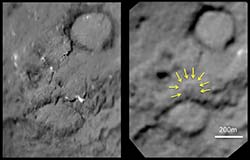 |
NASA Releases Images of Man-Made Crater on Comet
This pair of images shows the before-and-after comparison of the part of comet Tempel 1 that was hit by the impactor from NASA's Deep Impact spacecraft. Image credit: NASA/JPL-Caltech/University of Maryland/Cornell [ more ]
|
|
Comet Tempel 1 Contents |
|
Comets |
|
Shoemaker-Levy 9
|
|
Comet Information |
The spacecraft made its closest approach to comet Tempel 1 on Monday, Feb. 14, at 8:40 p.m. PST (11:40 p.m. EST) at a distance of approximately 178 kilometers (111 miles). Stardust took 72 high-resolution images of the comet. It also accumulated 468 kilobytes of data about the dust in its coma, the cloud that is a comet's atmosphere. The craft is on its second mission of exploration called Stardust-NExT, having completed its prime mission collecting cometary particles and returning them to Earth in 2006.
The Stardust-NExT mission met its goals, which included observing surface features that changed in areas previously seen during the 2005 Deep Impact mission; imaging new terrain; and viewing the crater generated when the 2005 mission propelled an impactor at the comet.
"This mission is 100 percent successful," said Joe Veverka, Stardust-NExT principal investigator of Cornell University, Ithaca, N.Y. "We saw a lot of new things that we didn't expect, and we'll be working hard to figure out what Tempel 1 is trying to tell us."
Several of the images provide tantalizing clues to the result of the Deep Impact mission's collision with Tempel 1. "We see a crater with a small mound in the center, and it appears that some of the ejecta went up and came right back down," said Pete Schultz of Brown University, Providence, R.I. "This tells us this cometary nucleus is fragile and weak based on how subdued the crater is we see today."
Engineering telemetry downlinked after closest approach indicates the spacecraft flew through waves of disintegrating cometary particles, including a dozen impacts that penetrated more than one layer of its protective shielding.
"The data indicate Stardust went through something similar to a B-17 bomber flying through flak in World War II," said Don Brownlee, Stardust-NExT co-investigator from the University of Washington in Seattle. "Instead of having a little stream of uniform particles coming out, they apparently came out in chunks and crumbled."
While the Valentine's Day night encounter of Tempel 1 is complete, the spacecraft will continue to look at its latest cometary obsession from afar.
"This spacecraft has logged over 3.5 billion miles since launch, and while its last close encounter is complete, its mission of discovery is not," said Tim Larson, Stardust-NExT project manager at JPL. "We'll continue imaging the comet as long as the science team can gain useful information, and then Stardust will get its well-deserved rest."
Stardust-NExT is a low-cost mission that is expanding the investigation of comet Tempel 1 initiated by the Deep Impact spacecraft. The mission is managed by JPL for NASA's Science Mission Directorate in Washington. Lockheed Martin Space Systems in Denver built the spacecraft and manages day-to-day mission operations.
DC Agle 818-393-9011 Jet Propulsion Laboratory, Pasadena, Calif. agle@jpl.nasa.gov
Dwayne Brown 202-358-1726 NASA Headquarters, Washington dwayne.c.brown@nasa.gov
Blaine Friedlander 607-254-6235 Cornell University, Ithaca, N.Y. bpf2@cornell.edu
2011-056
 Tempel 1 Impact Site
Tempel 1 Impact Site
This pair of images shows the before-and-after comparison of the part of comet Tempel 1 that was hit by the impactor from NASA's Deep Impact spacecraft.
The left-hand image is a composite made from images obtained by Deep Impact in July 2005. The right-hand image shows arrows identifying the rim of the crater caused by the impactor. The crater is estimated to be 150 meters (500 feet) in diameter. This image also shows a brighter mound in the center of the crater likely created when material from the impact fell back into the crater. An unannotated version of this image is can be seen at PIA13873.
(Courtesy NASA/JPL-Caltech/University of Maryland/Cornell)
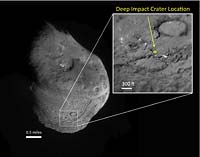 Comet Tempel 1, in Context
Comet Tempel 1, in Context
This image shows the area where scientists predicted an impactor released from NASA's Deep Impact spacecraft in July 2005 would hit the surface of comet Tempel 1.
This image was obtained by Deep Impact's impactor during its path into the comet.
(Courtesy NASA/JPL-Caltech/University of Maryland)
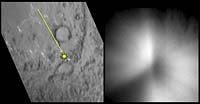 Deep Impact's Effect on Tempel 1
Deep Impact's Effect on Tempel 1
This pair of images shows a before-and-after comparison of the area on comet Tempel 1 targeted by an impactor from NASA's Deep Impact spacecraft in July 2005. The left-hand image is one of the last obtained of the Tempel 1 surface by the impactor's high resolution imager before the impactor hit the surface. An arrow shows the direction the impactor traveled toward the surface, with a yellow spot that shows the impact target. The right-hand image shows the plume of material kicked up by the impact that obscures the surface. It was obtained about 700 seconds after the impact.
(Courtesy NASA/JPL-Caltech/University of Maryland)
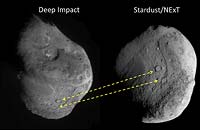 Tempel 1, as Seen by Two Spacecraft
Tempel 1, as Seen by Two Spacecraft
These two images show the different views of comet Tempel 1 seen by NASA's Deep Impact spacecraft (left) and NASA's Stardust spacecraft (right). Two craters, about 300 meters (1,000 feet) in diameter, help scientists locate the area hit by the impactor released by Deep Impact in July 2005. The dashed lines correlate the features.
Stardust approached the comet from a different angle on Feb. 14, 2011.
(Courtesy NASA/JPL-Caltech/University of Maryland/Cornell)
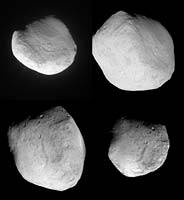 Four Views of Comet Tempel 1
Four Views of Comet Tempel 1
This image mosaic shows four different views of comet Tempel 1 as seen by NASA's Stardust spacecraft as it flew by on Feb. 14, 2011. The images progress in time beginning at upper left, moving to upper right, then proceeding from lower left to lower right. When the spacecraft first approached, it got a clear look at the same surface that was imaged previously by NASA's Deep Impact mission in 2005. Deep Impact sent a projectile into the comet, creating a crater that is located in the upper left image, but is difficult to see at this particular contrast level.
As Stardust flew closer to the comet, it began to see new territory that had not been imaged before. The new territory appears on the left side of the upper right image. The Deep Impact crater is also located in this view, on the right side.
Both the upper right and lower left images are the closest approach images for Stardust, taken at 3 seconds before, and 3 seconds after, the closest approach. The images were taken from a distance of about 185 kilometers (115 miles). In the lower left image, the vast majority of terrain pictured had not been seen until now. The fourth image, at lower right, shows Stardust's view as the spacecraft was on the way out.
The image at upper left was taken 15 seconds before the encounter, or closest approach, from a distance of 244 kilometers (152 miles); the image at lower right was taken 15 seconds after encounter, from a distance of 245 kilometers (152 miles).
(Courtesy NASA/JPL-Caltech/Cornell)
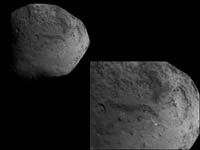 New Territory on Tempel 1
New Territory on Tempel 1
This image obtained by NASA's Stardust spacecraft shows a side of the nucleus of comet Tempel 1 that has never been seen before. In the image, three terraces of different elevations are visible, with dark, banded scarps, or slopes, separating them. The widest of the banded slopes is about 2 kilometers (1 mile). The lowest terrace has two circular features that are about 150 meters (500 feet) in diameter.
An inset on the right shows a closer view.
This image was taken on February 14, 2011, at 8:39:21 p.m. PST. The spatial resolution is about 15 meters (50 feet) per pixel.
NASA's Deep Impact spacecraft visited this same comet in July 2005 and also observed the presence of layers on the other side of the comet.
This image shows at least 90 percent new territory.
(Courtesy NASA/JPL-Caltech/Cornell)
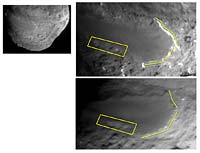 Changes to Smooth Terrain (Annotated)
Changes to Smooth Terrain (Annotated)
This image layout depicts changes in the surface of comet Tempel 1, observed first by NASA's Deep Impact Mission in 2005 (top right) and again by NASA's Stardust-NExT mission on Feb. 14, 2011 (bottom right). Between the two visits, the comet made one trip around the sun. The image at top left is a wider shot from Deep Impact.
The smooth terrain is at a higher elevation than the more textured surface around it. Scientists think that cliffs, illustrated with yellow lines to the right, are being eroded back to the left in this view. The cliffs appear to have eroded as much as 20 to 30 meters (66 to 100 feet) in some places, since Deep Impact took the initial image. The box shows depressions that have merged together over time, also from erosion. This erosion is caused by volatile substances evaporating away from the comet.
(Courtesy NASA/JPL-Caltech/Cornell)
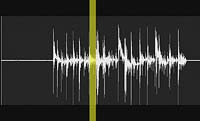 Sounds of a Comet Encounter
Sounds of a Comet Encounter
During its Feb. 14, 2011, flyby of comet Tempel 1, an instrument on the protective shield on NASA's Stardust spacecraft was pelted by dust particles and small rocks, as can be heard in this audio track. The instrument, called the Dust Flux Monitor instrument, measures sound waves and electrical pulses from dust impacts. The movie is a visual representation of the sounds.
Scientists think that the observed bursts of particles are from clumps of debris, formed by fragmenting balls of ice and dust. This and other comet studies show that, contrary to previous expectations, icy dust balls that leave a comet continually break up in space.
The movie and audio track represent a fraction of the approximately 5,000 total impacts observed over a period of about 11 minutes.
(Courtesy NASA/JPL-Caltech/Cornell/Univ. of Chicago)
 Stardust Swoops by Tempel 1
Stardust Swoops by Tempel 1
This movie shows what it was like for NASA's Stardust spacecraft to fly by comet Tempel 1. It covers the period between 8:35:26 p.m. to 8:43:08 p.m. PST on Feb. 14, 2011 (4:35:26 a.m. to 4:43:08 a.m. UTC, Feb. 15, 2011, according to the clock kept aboard the spacecraft). The spacecraft images were taken at a distance of 2,462 kilometers (1,530 miles) away from the center of the comet and get to within 185 kilometers (115 miles). By the end of the movie, the spacecraft is 2,594 kilometers (1,611 miles) away from the center of the comet.
At the time of the encounter, comet Tempel 1 was approximately 335 million kilometers (208 million miles) away from Earth. Tempel 1 is oblong in shape and has an average diameter of about 6 kilometers (4 miles).
(Courtesy NASA/JPL-Caltech/Cornell)
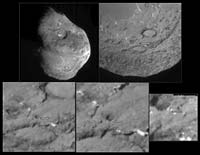 Before the Deep Impact Collision
Before the Deep Impact Collision
This series of images shows the area where NASA's Deep Impact probe collided with the surface of comet Tempel 1 in 2005. The view zooms in as the images progress from top left to right, and then bottom left to right. The arrow points to the site of the impact, as indicated by trajectory and imaging data from the Deep Impact mission.
(Courtesy NASA/JPL-Caltech/Univ. of Maryland)
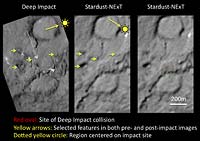 Comet Tempel 1 Six Years Later
Comet Tempel 1 Six Years Later
This image shows the surface of comet Tempel 1 as seen before and after NASA's Deep Impact mission sent a probe into the comet in 2005. The region was imaged by Deep Impact before the collision (left), then six years later on Feb. 14, 2011, by NASA's Stardust-NExT mission, which flew by the comet, snapping pictures along the way (middle and right images).
The white arrow shows the trajectory of the impact probe, and the red oval shows the area of impact, based on the trajectory data. The large yellow arrows show the location of the sun, while the little yellow arrows show selected features in the both the pre- and post-impact images. The yellow dotted circle shows the region of the impact site.
Scientists are still analyzing the disturbance to the surface on comet Tempel 1 where the Deep Impact collision occurred.
(Courtesy NASA/JPL-Caltech/Cornell/Univ. of Maryland)
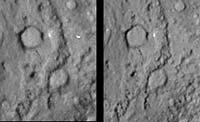 Comet Tempel 1 in Stereo
Comet Tempel 1 in Stereo
Normal stereo image pair covering the region of the Deep Impact site from the Stardust-NExT mission (left image is meant to be seen by left eye). The diameter of the large crater at the top of the image is about 300 meters (almost 1,000 feet).
These images are for viewing with a stereoscope, or for producing a merged 3-D image.
(Courtesy NASA/JPL-Caltech/Cornell)
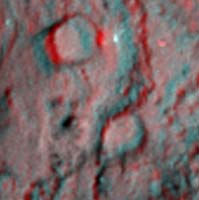 Deep Impact Site in 3-D
Deep Impact Site in 3-D
This 3-D image, or anaglyph, shows the region where NASA's Deep Impact mission sent a probe into the surface of comet Tempel 1 in 2005. This picture was taken six years after the Deep Impact collision, on Feb. 14, 2011, by NASA's Stardust-NExT mission, which flew by the comet, snapping pictures along the way.
Red/blue 3-D glasses are required to view this image (the red filter should be over the left eye). Disturbances to the impact site located at the center of the image are subtle.
The diameter of the large crater at the top of the image is about 300 meters (almost 1,000 feet).
(Courtesy NASA/JPL-Caltech/Cornell)